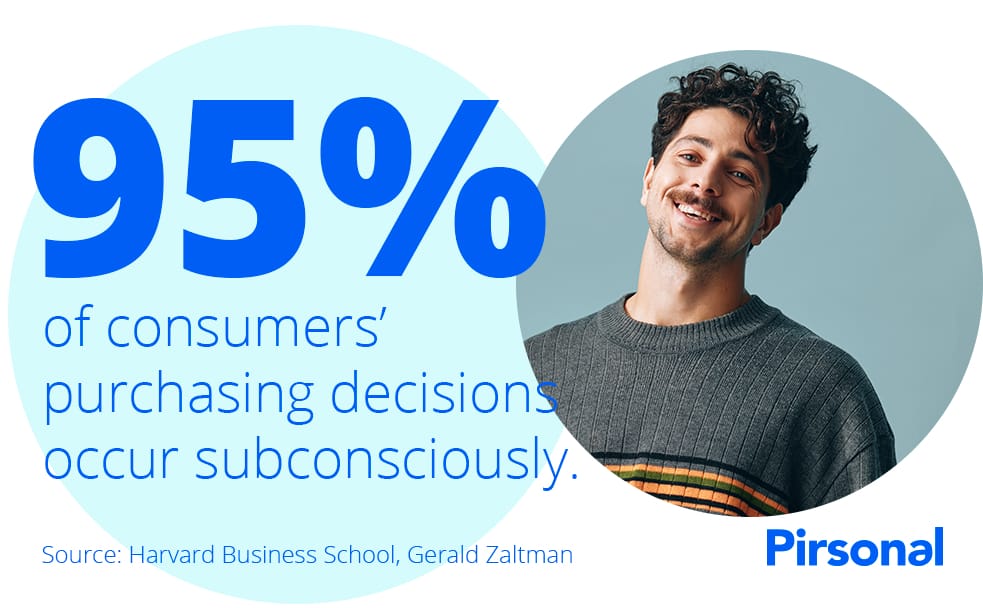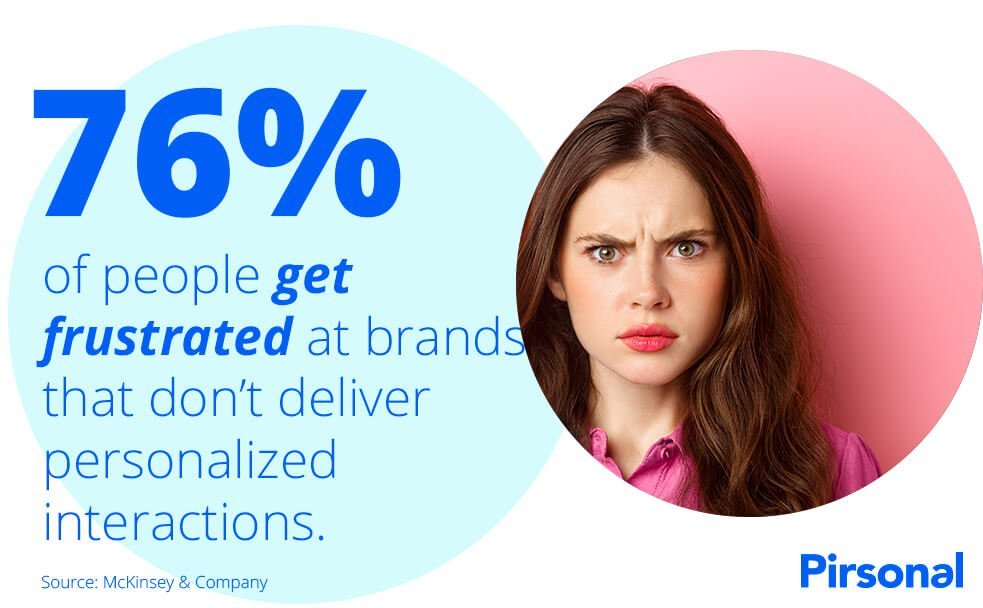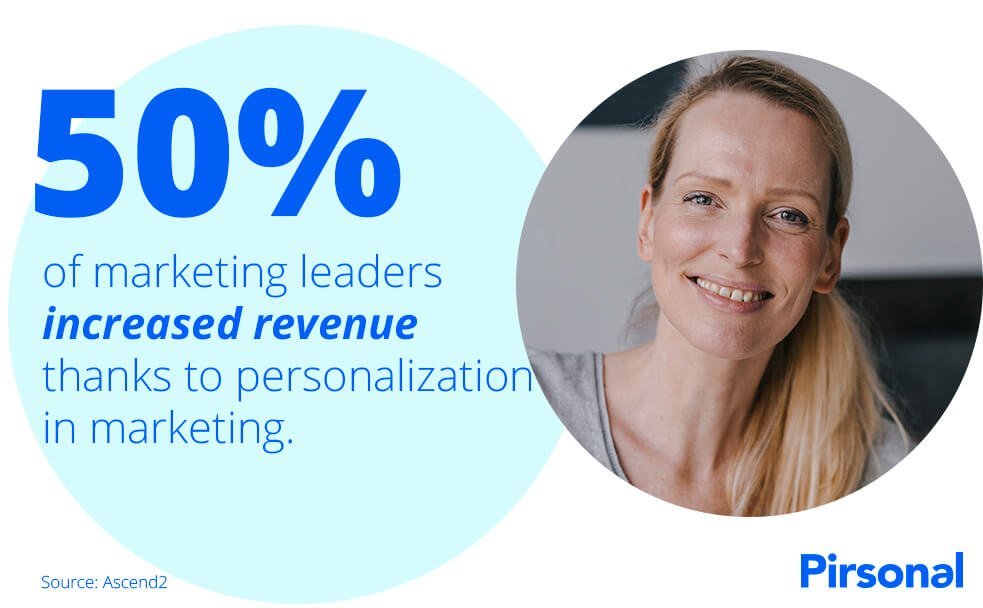Marketing leaders today face a double-edged sword. On one hand, content creation is now easier thanks to AI tools for creating videos, emails, and articles, as well as marketing automation platforms.
On the other hand, this ease of creation has led to a content overload, bombarding audiences with generic messages and causing marketing fatigue.
¿El resultado?
Leads and customers are tuning out the noise.
To break through the clutter and truly connect, brands need to get personal and strategic. This is where the power duo of storytelling and personalization steps in.
Today, you’ll learn about the power of storytelling and personalization to go beyond short-term engagement and help your audience take action.
Why Storytelling Matters: The Science of Narrative Engagement
We are all wired for stories since the dawn of time. Stories helped us learn, share experiences, and build communities around campfires millennia ago.
And, as you can tell, in the age of digital marketing, the essence remains the same.
Cognitive psychologist Jerome Bruner suggests that when a fact is wrapped in a story, we are 22 times more likely to remember it.
This is because stories tap into our emotions, creating a deeper connection with the brand and the message it conveys.
Studies also show that in marketing and sales, emotions matter. Lots. Most of the buying decisions we all make are based on emotions.
Therefore, storytelling helps marketing leaders create memorable interactions, messages, and campaigns in three ways:
- Emotional Resonance: Stories evoke feelings, making brands relatable and fostering empathy.
- Cognitive Processing: Narratives activate different parts of the brain, making information easier to understand and retain.
- Engagement: Stories capture attention, keeping audiences hooked and eager to learn more.
The Framework of Storytelling: Building Your Brand Narrative
How can storytelling be used in marketing to create impactful campaigns that capture your audience’s attention and motivate them to take action?
Here are four approaches you can follow:
- The Hero’s Journey: This classic story structure – a relatable protagonist facing challenges and achieving a transformation – can be adapted to your brand narrative. Your audience becomes the hero, and your product or service becomes the guide or tool that helps them overcome obstacles and achieve their desired outcome.
- Conflict and Resolution: Showcase the common pain points your target audience faces and demonstrate how your brand offers the solution.
- Character Development: Create relatable characters that your audience can identify with, even if they are fictionalized personas.
- Emotional Arc: Take your audience on an emotional journey, from frustration and struggle to hope, triumph, and satisfaction.
You’ll see all of these approaches in many TV commercials, but also in the movies! Why? Because they work, they stick to our minds, catch our curiosity, and help us connect with the story.
Using Emotional Motivators for Engaging Storytelling

Most buyers make decisions subconsciously
Customers who are fully connected and have an emotional connection are 52% more valuable on average than customers who are only highly satisfied.
The most effective approach is to use relatable stories that tap into the emotions driving your customers.
This is what emotional motivators bring to your marketing. There are over 300 of them, but brand strategists and creative teams often focus on the following 10 because they are incredibly effective.
Top 10 emotional motivators or drivers used in marketing:
- “Feel a sense of thrill”: This motivator revolves around experiencing intense pleasure and excitement. Individuals seek activities, products, or experiences that offer them a sense of adventure, joy, and excitement. For businesses, tapping into this motivator involves creating offerings that evoke exhilaration or enthusiasm.
- “Feel a sense of belonging”: People have an innate desire to belong, be accepted, and connect with communities or groups that resonate with their values. Brands that foster a sense of belongingness cultivate loyal customer bases by creating inclusive environments or communities around their products or services.
- “Feel a sense of freedom”: This motivator revolves around the desire for autonomy, independence, and the ability to make choices without constraints. Businesses catering to this motivator offer products or experiences that enable customers to feel liberated or empowered in their decisions.
- “Have confidence in the future”: It encompasses the yearning for security, assurance, and a positive outlook on what lies ahead. Brands that instill confidence in customers regarding their future, be it through reliable products or trusted services, tend to resonate deeply.
- “Be the person I want to be”: This motivator revolves around aspirations and self-improvement. Individuals seek products or experiences that align with their desired self-image, allowing them to express or embody their ideal identities.
- “Feel a sense of well-being”: This encompasses the pursuit of physical, mental, or emotional wellness. Brands catering to this motivator focus on offering products or services that contribute to customers’ overall well-being, be it through relaxation, health, or peace of mind.
- “Feel a sense of excitement”: It involves seeking stimulation, novelty, and fresh experiences. Businesses that offer innovative or cutting-edge products or services can tap into this motivator by providing excitement or novelty.
- “Be secure”: This motivator is centered around the need for safety, stability, and protection. Brands that prioritize customer safety or offer reliable, trustworthy solutions often resonate strongly with customers seeking security.
- “Feel a sense of accomplishment”: It pertains to the desire for recognition, achievement, and success. Businesses that help customers achieve their goals or celebrate milestones can leverage this motivator effectively.
- “Feel a sense of control”: This involves the desire for influence, authority, and the ability to direct one’s circumstances. Brands that empower customers or offer tools for managing their lives align with this motivator.
Take into account that we all go through different emotions as we advance in the customer journey.
Therefore, emotions are dynamic, the same way your marketing should be.
The Personalization Imperative: Tailoring Stories for Individual Impact

The majority of people dislike one-to-many marketing
Storytelling is powerful, but personalization takes it to the next level. Most customers demand it because otherwise they get frustrated at brands that don’t offer personalized experiences.
In today’s data-driven marketing landscape, personalization allows you to tailor your story to resonate with individual audience members.
But there are many benefits personalization brings to your marketing game. In the following video, I summarize them:
This can be leads, customers, or even employees.
Over the last decade, I’ve seen this firsthand in video personalization programs, but the same applies to any interaction and message.
You can do this in different ways:
- Customer Segmentation: Group your audience based on demographics, interests, and behaviors. I recommend going another step further to specific personas. Want to take it to the next level? Use what I call “compradores aumentados“.
- Dynamic Content: Use audience data to personalize videos, landing pages, emails, and other marketing materials with specific messaging and audiovisual content. With software like Pirsonal’s you can automatically create personalized videos, landing pages, and interactions to engage with your audience.
- Interactive Storytelling: Develop choose-your-own-adventure style campaigns where audience choices shape the narrative. Keep in mind that, on many occasions, a more classic approach will make more sense: offering one path and one personalized call-to-action based on your goals and available customer data. You can also do this with software de video interactivo.
The Personalization + Storytelling Equation: Examples in Action
There are many ways you can use personalized storytelling to better engage with your audience.
For example, the personalized video example above helps a customer named “Henry” understand what the forbearance process is about, and what are his next steps in relation to his own process.
Let’s see other ways storytelling and personalization can join forces to create impactful marketing campaigns.
- Case Studies: Instead of generic case studies, turn them into stories of real customers overcoming challenges with your product or service. Include quotes, challenges faced, and the positive outcomes achieved.
- Testimonial Videos: Feature real customers sharing their experiences and the positive impact your brand has had on their lives. You can enhance the impact of your videos by automatically personalizing them with Pirsonal.
- Interactive Content: Create quizzes or assessments that help diagnose audience needs and then deliver personalized stories and recommendations based on their results.
Benefits Beyond Engagement: The Long-Term Impact

Personalization in marketing helps marketers increase revenue
The marriage of storytelling and personalization leads to a range of benefits that go beyond short-term engagement:
- Brand Loyalty: Personalized stories create a deeper emotional connection, fostering brand loyalty and advocacy.
Increased Customer Lifetime Value: Engaged customers are more likely to make repeat purchases and become brand ambassadors. - Improved Conversion Rates: Targeted stories with relevant solutions are more likely to resonate with leads and convert them into paying customers. For example, 50% of marketing leaders increased revenue thanks to personalization.
- Data-Driven Insights: By tracking audience engagement with personalized stories, marketers gain valuable insights into customer preferences and buying behaviors.
Standing out requires a shift from generic messaging to personalized storytelling.
By crafting narratives that resonate with your audience’s needs and aspirations, and then tailoring these stories with specific data-driven insights, you can forge deeper connections with leads and customers throughout their journey.
This powerful duo of storytelling and personalization will not only grab attention in a crowded market but also build long-term brand loyalty and drive sustainable business growth.
Ready to Get Started?
Here are some achievable steps to get started with personalized storytelling:
- Know Your Audience: Conduct thorough market research and customer persona development to understand your ideal customer’s demographics, needs, goals, and pain points. This forms the foundation for crafting relatable stories and personalizing them for maximum impact.
- Content Audit: Evaluate your existing marketing content to identify opportunities to weave storytelling and personalization elements into your existing materials. For instance, do you have any videos that you can personalize in a scalable way?
- Start Small: Don’t be overwhelmed by the idea of a complete overhaul. Begin by incorporating storytelling and personalization techniques into specific campaigns or content pieces. Grow from there.
- Embrace Authenticity: Consumers are drawn to genuine stories. Focus on highlighting your brand’s values, mission, and the human element behind your company.
- Measure and Adapt: Track the performance of your storytelling and personalization efforts. Analyze metrics like engagement, click-through rates, and conversions to identify what resonates with your audience and adapt your approach accordingly.
Don’t worry if your team lacks experience in this area. We have the expertise to support you every step of the way.
Personalization goes beyond just using software; it requires implementing the right strategies.
Get in touch with us today to discover the remarkable potential of storytelling and video personalization in captivating your audience.
En conclusión
Storytelling and personalization are powerful tools in your marketing arsenal. By harnessing the emotional connection that stories create and tailoring those stories to individual needs, you can rise above the content clutter and achieve meaningful engagement with your audience.
In this competitive landscape, it’s not just about creating content; it’s about creating content that connects, resonates, and inspires action.
Recuerda, people don’t just buy products and services; they buy into stories. Make yours a story worth telling, and personalize it for maximum impact on your audience’s journey.

